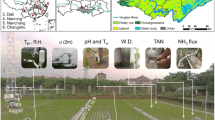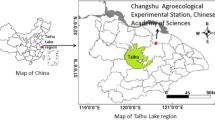Abstract
Ammonia (NH3) volatilization was measured with the continuous airflow enclosure chamber method under different urea application amounts using pots in paddy fields in Erhai Lake Watershed, China. Several factors, such as the urea nitrogen application amount, days after fertilization, NH4 +-N concentration and pH of surface water, and climate, that could affect ammonia volatilization were also studied. The results indicated that ammonia volatilization loss increased linearly with increasing amounts of applied urea. The ratios of the ammonia volatilization loss to the applied nitrogen ranged from 16.59 to 18.43 % with different nitrogen application amounts. The ammonia volatilization loss peaked within the first 3 days after fertilization, which accounted for 65–82 % of the total ammonia loss in each period. We observed the following degree of the effects of various factors on ammonia volatilization: NH4 +-N concentration of surface water > urea application amount > pH of surface water > days after fertilization > water temperature of surface water. The wind velocity and rainfall were the key factors affecting ammonia volatilization. The model of ammonia volatilization flux was established by using the measured dates from 2013 and was represented as Y = 0.008(x1 + x2 + x3) + e0.056x4−0.068x5−0.623 (R 2 = 0.81, P < 0.0001). The model was verified by using the measured dates from 2012. The calculated values fitted well with the field observations. However, the model parameters need to be amended using the model to predict the ammonia volatilization flux in the rice season from other regions.






Similar content being viewed by others
References
Al-Kanani T, Mackenzie AF, Barthakur NN (1991) Soil water and ammonia volatilization relationships with surface-applied nitrogen fertilizer solutions. Soil Sci Soc Am J 55(6):1761–1766
Aneja VP, Roelle PA, Murray GC, Southerland J, Erisman JW, Fowler D, Asman WAH, Patni N (2001) Atmospheric nitrogen compounds II: emissions, transport, transformation, deposition and assessment. Atmos Environ 35(11):1903–1911
Black AS, Sherlock RR, Smith NP (1987) Effect of timing of simulated rainfall on ammonia volatilization from urea, applied to soil of varying moisture content. J Soil Sci 38(4):679–687
Cai GX, Zhu ZL (1995) Evaluation of gaseous nitrogen losses from fertilizers applied to flooded rice fields. Acta Pedol Sin 32(Supp. 2):128–135 (in Chinese)
Cameron KC, Di HJ, Moir JL (2013) Nitrogen losses from the soil/plant system: a review. Ann Appl Biol 162:145–173
Chen AQ, Lei BK, Lu Y, Mao YT, Zhang D (2013) Study on nitrogen application rate tolerance based on rice yield and ecological security in hilly areas of South China. Trans Chin Soc Agric Eng 29(9):131–139 (in Chinese)
Denmead OT, Freney JR, Simpson JR (1982) Dynamics of ammonia volatilization during furrow irrigation of maize. Soil Sci Soc Am J 46:149–155
Emmett BA (2007) Nitrogen saturation of terrestrial ecosystems: some recent findings and their implications for our conceptual framework. Water Air Soil Pollut Focus 7(1–3):99–109
Fan MX, Mackenzie AF (1993) Urea and phosphate interactions in fertilizer microsites: ammonia volatilization and pH changes. Soil Sci Soc Am J 57(3):839–845
Fan XH, Song YS, Lin DX, Yang LZ, Zhou JM (2005) Ammonia volatilization losses from urea applied to wheat on a paddy soil in Taihu Region. China. Pedosphere 15(1):59–65
FAO, IFA (2001) Global estimates of gaseous emissions of NH3 NO and N2O from agricultural land. Food and Agriculture Organization of the United Nations (FAO) and International Fertilizer Industry Association (IFA), Rome, p 106. http://www.fertilizer.org/ifa
Ferguson RB, Kissel DE (1986) Effects of soil drying on ammonia volatilization from surface-applied urea. Soil Sci Soc Am J 50(2):485–490
Ferm M (1998) Atmospheric ammonia and ammonium transport in Europe and critical loads: a review. Nutr Cycl Agroecosyst 51(1):5–17
Fillery IRP, Simpson JR, de Datta SK (1984) Influence of field environment and fertilizer management on ammonia loss from flooded rice. Soil Sci Soc Am J 48(4):914–920
Fillery IRP, Simpson JR, de Datta SK (1986) Contribution of ammonia volatilization to total nitrogen loss after applications of urea to wetland rice fields. Fertil Res 8(3):193–202
Freney JR, Leuning R, Simpson JR, Denmead OT, Muirhead WA (1985) Estimating ammonia volatilization from flooded rice fields by simplified techniques. Soil Sci Soc Am J 49(4):1049–1054
Freney JR, Trevitt ACF, de Datta SK, Obcemea WN, Real JG (1990) The interdependence of ammonia volatilization and denitrification as nitrogen loss processes in flooded rice fields in the Philippines. Biol Fertil Soils 9(1):31–36
Hayashi K, Nishimura S, Yagi K (2006) Ammonia volatilization from the surface of a Japanese paddy field during rice cultivation. Soil Sci Plant Nutr 52(4):545–555
Hayashi K, Nishimura S, Yagi K (2008) Ammonia volatilization from a paddy field following applications of urea: rice plants are both an absorber and an emitter for atmospheric ammonia. Sci Total Environ 390(2):485–494
Huang JB, Fan XH, Zhang SL (2006) Ammonia volatilization from nitrogen fertilizer in the rice field of Fe-leachi-stagnic anthrosols in the Taihu Lake Region. Acta Pedol Sin 43(5):786–792 (in Chinese)
Jayaweera GR, Mikkelsen DS (1990) Ammonia volatilization from flooded soil systems: a computer model. I. Theoretical aspects. Soil Sci Soc Am J 54:1447–1455
Jayaweera GR, Mikkelsen DS (1991) Assessment of ammonia volatilization from flooded soil systems. Adv Agron 45(3):303–356
Jenkinson DS (1990) An introduction to the global nitrogen cycle. Soil Use Manag 6(2):56–61
Kissel DE, Brewer HL, Arkin GF (1977) Design and test of a field sampler for ammonia volatilization. Soil Sci Soc Am J 41(6):1133–1138
Kissel DE, Cabrera ML, Vaio N, Craig JR, Rema JA, Morris LA (2004) Rainfall timing and ammonia loss from urea in a loblolly pine plantation. Soil Sci Soc Am J 68:1744–1750
Li H, Liang XQ, Chen YX, Tian GM, Zhang ZJ (2008) Ammonia volatilization from urea in rice fields with zero-drainage water management. Agric Water Manag 95(8):887–894
Lin DX, Fan XH, Hu F, Zhao HT, Luo JF (2007) Ammonia volatilization and nitrogen utilization efficiency in response to urea application in rice fields of the Taihu Lake Region. China Pedosphere 17(5):639–645
Liu GS, Jiang NF, Zhang LD (1996) Soil Physical and Chemical Analysis. Standard Press, China
Liu Y, Li WL, Zhou XJ (2005) Simulation study of secondary aerosol in the summer in the North China plain. Sci China Ser D Earth Sci 35(Supp I):156–166 in Chinese
Meyer ML, Bloom PR, Grava J (1989) Transformation and losses of applied nitrogen-15 labeled ammonium in a flooded organic soil. Soil Sci Soc Am J 53(1):79–85
Ministry of Environmental Protection of the People’s Republic of China (2002) Environmental quality standards for surface water (GB3838-2002). China Environmental Science Press, Beijing
Mosier A, Kroeze C, Nevison C, Oenema O, Seitzinger S, van Cleemput O (1998) Closing the global N2O budget: nitrous oxide emissions through the agricultural nitrogen cycle. Nutr Cycl Agroecosyst 52(2–3):225–248
Peng SZ, Yang SH, Xu ZJ (2009) Ammonia volatilization and its influence factors of paddy field under water-saving irrigation. Trans CSAE 25(8):35–39 (in Chinese)
Simpson JR, Muirhead WA, Bowmer KH, Cai GX, Freney JR (1988) Control of gaseous nitrogen losses from urea applied to flooded rice soils. Fertil Res 18(1):31–47
Skeffington RA (1990) Accelerated nitrogen inputs—A new problem or a new perspective? Plant Soil 128(1):1–11
Sommer SG, Schjoerring JK, Denmead OT (2004) Ammonia emission from mineral fertilizers and fertilized crops. Adv Agron 82:557–622
Song YS, Fan XH, Lin DX, Yang LZ, Zhou JM (2004) Ammonia volatilization from paddy fields in the Taihu Lake region and its influencing factors. Acta Pedol Sin 41(2):265–269 (in Chinese)
Sun KJ, Mao XY, Lu QM, Jia AP, Liao ZW (2004) Mitigation effect of several controlled-release N fertilizers on ammonia volatilization and related affecting factors. Chin J Appl Ecol 15(12):2347–2350 (in Chinese)
Tang QX, Ren TZ, Lei BK, Zhai LM, Hu WL, Zhang JZ, Lin T, Liu HB (2011) Characteristics of nitrogen and phosphorus loss in various crop rotation systems in northern watershed of Erhai Lake. Plant Nutr Fertil Sci 17(3):608–615 (in Chinese)
Tian GM, Cai ZC, Cao JL, Li XP (2001) Factors affecting ammonia volatilisation from a rice–wheat rotation system. Chemosphere 42(2):123–129
van Aardenne JA, Dentener FJ, Olivier JGJ, Klein Goldewijk CGM, Lelieveld J (2001) A 1° × 1° resolution data set of historical anthropogenic trace gas emissions for the period 1890–1990. Glob Biogeochem Cycles 15(4):909–928
Velthof GL, van Bruggen C, Groenestein CM, de Haan BJ, Hoogeveen MW, Huijsmans JFM (2012) A model for inventory of ammonia emissions from agriculture in the Netherlands. Atmos Environ 46:248–255
Vlek PLG, Stumpe JM, Byrnes BH (1980) Urease activity and inhibition in flooded soil systems. Fertil Res 1(3):191–202
Williams EJ, Hutchinson GL, Fehsenfeld FC (1992) NOx and N2O emissions from soil. Glob Biogeochem Cycles 6(4):351–388
Wolfe AH, Patz JA (2002) Reactive nitrogen and human health: acute and long-term implications. AMBIO: J Hum Environ 31(2):120–125
Wu PP, Liu JJ, Yang XX, Shang QY, Zhou Y, Xie XL, Shen QR, Guo SW (2009) Effects of different fertilization systems on ammonia volatilization from double-rice cropping field in red soil region. Chin J Rice Sci 23(1):85–93 (in Chinese)
Xia WJ, Zhou W, Liang GQ, Wang XB, Sun JW, Li SL, Hu C, Chen YF (2010) Effect of optimized nitrogen application on ammonia volatilization from paddy field under wheat–rice rotation system. Plant Nutr Fertil Sci 16(1):6–13 (in Chinese)
Xing GX, Zhu ZL (2000) An assessment of N loss from agricultural fields to the environment in China. Nutr Cycl Agroecosyst 57(1):67–73
Xu JG, Heeraman DA, Wang Y (1993) Fertilizer and temperature effects on urea hydrolysis in undisturbed soil. Biol Fertil Soils 16(1):63–65
Xu JZ, Peng SZ, Yang SH, Wang WG (2012) Ammonia volatilization losses from a rice paddy with different irrigation and nitrogen managements. Agric Water Manag 104:184–192
Xu JZ, Liao LX, Tan JY, Shao XH (2013) Ammonia volatilization in gemmiparous and early seedling stages from direct seeding rice fields with different nitrogen management strategies: a pots experiment. Soil and Tillage Res 126:169–176
Ye SC, Lin ZC, Dai QG, Jia YS, Gu HY, Chen JD, Xu LS, Wu FG, Zhang HC, Hu ZY, Xu K, Wei HY (2011) Effects of nitrogen application rate on ammonia volatilization and nitrogen utilization in rice growing season. Chin J Rice Sci 25(1):71–78 (in Chinese)
Yu Y, Zhang M, Qian SQ, Li DM, Kong FX (2010) Current status and development of water quality of lakes in Yunnan-Guizhou Pateau. J Lake Sci 22(6):820–828 (in Chinese)
Zhao X, Xie YX, Xiong ZQ, Yan XY, Xing GX, Zhu ZL (2009) Nitrogen fate and environmental consequence in paddy soil under rice-wheat rotation in the Taihu lake region, China. Plant Soil 319:225–234
Zhu ZL, Cai GX, Simpson JR, Zhang SL, Chen DL, Jackson AV, Freney JR (1988) Processes of nitrogen loss from fertilizers applied to flooded rice fields on a calcareous soil in north-central China. Fertil Res 18(2):101–115
Zhu ZL, Wen QJ (1992) Soil Nitrogen in China. Jiangsu Science Press, Nanjing (in Chinese)
Zhuang SY, Wang MK (2010) Model estimation of ammonia volatilization from a paddy rice field after application of a surface film-forming material. J Agric Sci 148:95–100
Acknowledgments
The authors thank the anonymous referees for their comments and are grateful for the Special Fund for Agro-scientific Research in the Public Interest (20100314-6), and the Natural Science Foundation of China (Grant Nos. 31160413, 41401248).
Author information
Authors and Affiliations
Corresponding author
Rights and permissions
About this article
Cite this article
Chen, A., Lei, B., Hu, W. et al. Characteristics of ammonia volatilization on rice grown under different nitrogen application rates and its quantitative predictions in Erhai Lake Watershed, China. Nutr Cycl Agroecosyst 101, 139–152 (2015). https://doi.org/10.1007/s10705-014-9660-7
Received:
Accepted:
Published:
Issue Date:
DOI: https://doi.org/10.1007/s10705-014-9660-7




